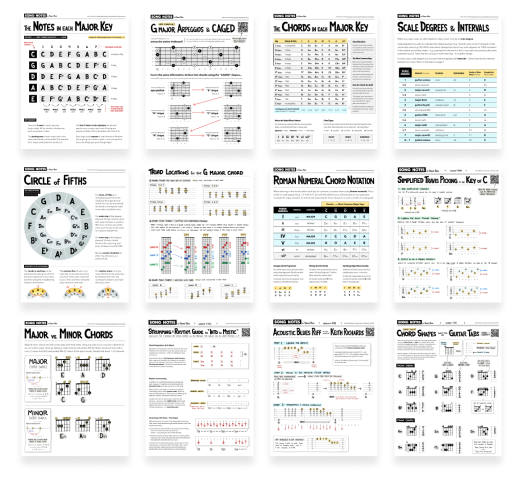The "Pretty Woman" lick, played 4 different ways
Lesson #183 • Oct 13, 2018
Description
I just saw A Star is Born (the 2018 version), which features a quick scene with Oh, Pretty Woman being played at a Roy Orbison tribute within the movie. This very distinctive riff gets the spotlight for a crucial scene, and at once I knew I had to learn how to play it.
It didn’t take me long to uncover a few different approaches to the riff that different online teachers suggested. Even though all the approaches played the same notes, they differed when it came to the frets, fingers, and strings played to make it all happen. Over the practice session that followed, I played this riff in a few different ways – working with what was suggested, pulling certain versions apart, putting other versions together.
Here’s my notes from that session, showing the different ways to play it. Each of these has something to teach us, and depending on your goal I hope some (or all) of these are helpful if you’d like to play the riff too.
👉 Looking for my full tutorial teaching Oh Pretty Woman in its entirety? View it here.
Instructional PDF 2 pages
Exercise 1: Easiest possible way to play the riff
Let’s start simple. Here, we’re going to utilize the open strings as much as possible (i.e., the strings where no fret is pressed down). You’ll only need your left index (2nd fret) and left ring finger (4th fret) for this exercise. This keeps things easy! I would guess that many advanced players would pass this version by, since the open strings don’t give you a lot to work with when it comes to the nuanced “sound” of the riff (when it comes to bends, slides, muting, etc). See the exercises below to learn what I mean here.
See my Instructional PDF for the tab.
Exercise 2: Getting the pinky involved
This version forsakes the open 4th string, replacing it with the 5th fret of the 5th string (played with the pinky). The difficulty here is turned up quite a bit, as the pinky coordination can be hard to muster! But this is a great exercise to strength your pinky, as well as work on its dexterity and flexibility. Also, I found the overall “sound” of this version (and the versions below) to be much more consistent, given that we’ve gotten rid of the open 4th string - which has a different quality-of-sound than the fretted notes surrounding it.
See my Instructional PDF for the tab.
Exercise 3: Moving up the fretboard
In this version, we’re going to move things between the 4th and 7th frets. This version moves the tough stretch over to our index finger (which has to hit the 4th fret of the 6th and 4th string). We’re still using our pinky, but the stretch is a bit more natural in my opinion. Try this version along side exercise #2, and pay attention to the different feelings they have (when it comes to your fingers stretching, etc).
See my Instructional PDF for the tab.
Exercise 4: Adding as many slides as possible
This one combines some of the phrases from exercise #2 and #3 – and does so in a way where three of the notes within the riff are “slid” into. This creates a very distinct effect, making things sound a bit more elegant and complex (but you don’t want to overdo it). Note that this comes with an extra degree of difficulty. For one, you’ll need to adjust the left hand fingers-you-use slightly from the prior exercises (see my video for reference) – this is so you can execute each slide while setting your fingers up to perform the slides that come afterwards. It can be tricky to learn, but at the same time very rewarding if you can master it.
See my Instructional PDF for the tab.
Parting thoughts
The main takeaway here: there can be multiple valid ways to play any song. Don’t think of these are “right” or “wrong” in an absolute sense. Instead, understand that each version offers different opportunities! What worked for the composer (when they wrote the song) may not be a match for you, given equipment or skill level or anything else. Play the version that makes sense depending on your goal, and you’ll be in good shape.
Enjoy My Lessons? Show Your Support!
Most of the lessons on my website are 100% free. If you have the means, please show your support with a tip jar contribution. I put many hours into every lesson — but it only takes you a minute to make a donation. You have my thanks!
Looking for More Song Lessons?
Featured Courses
Fun & Helpful Tools I've Made
Coming soon is Jambox – which shows all the video jam tracks I've made. It's note quite ready for the spotlight, but check it out if you like!
Subscribe to my YouTube channel
Be sure to never miss a lesson by subscribing on YouTube. I put out 2-3 new videos every week. These include full song lessons, as well as covers, practice tips, behind-the-scenes updates. Thanks!
Recent Lessons
-
Dec 19, 2025
"Fairytale of New York" by The Pogues
-
Dec 12, 2025
"The Christmas Song" by Nat King Cole
-
Dec 4, 2025
"If I Needed You" by Emmylou Harris & Don Williams
-
Nov 21, 2025
Learn to Play "Hey Joe", Step-by-Step
-
Nov 15, 2025
Songs Using the One-Four-Five Chords
-
October 31, 2025
"Long Cool Woman (In a Black Dress)" by The Hollies
-
October 24, 2025
"Dust in the Wind" Intro Fingerstyle, Step-by-Step
-
Oct 18, 2025
"America" by Simon & Garfunkel
-
Oct 8, 2025
Rhythm Deep-Dive: "Wild World" by Cat Stevens


